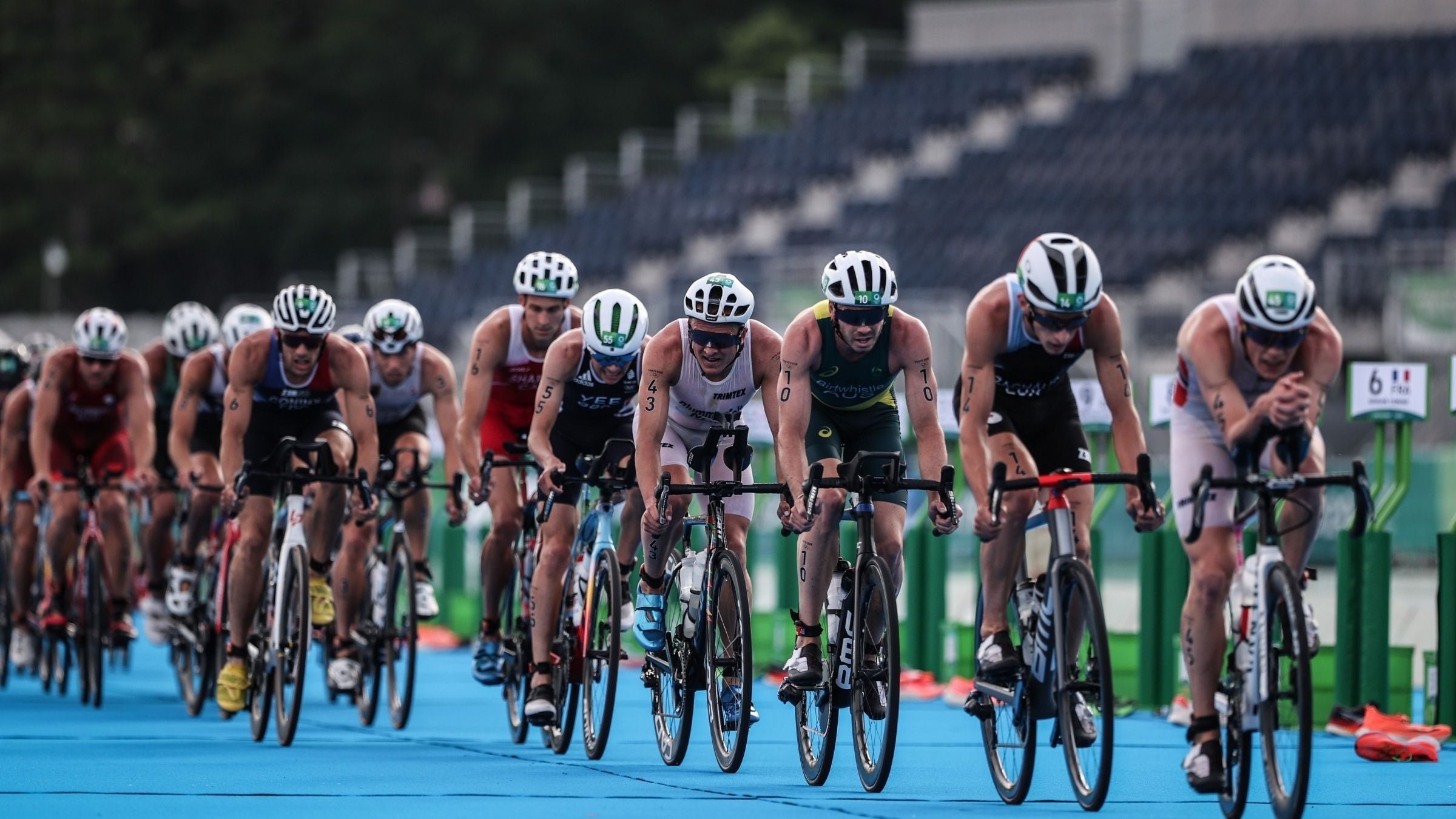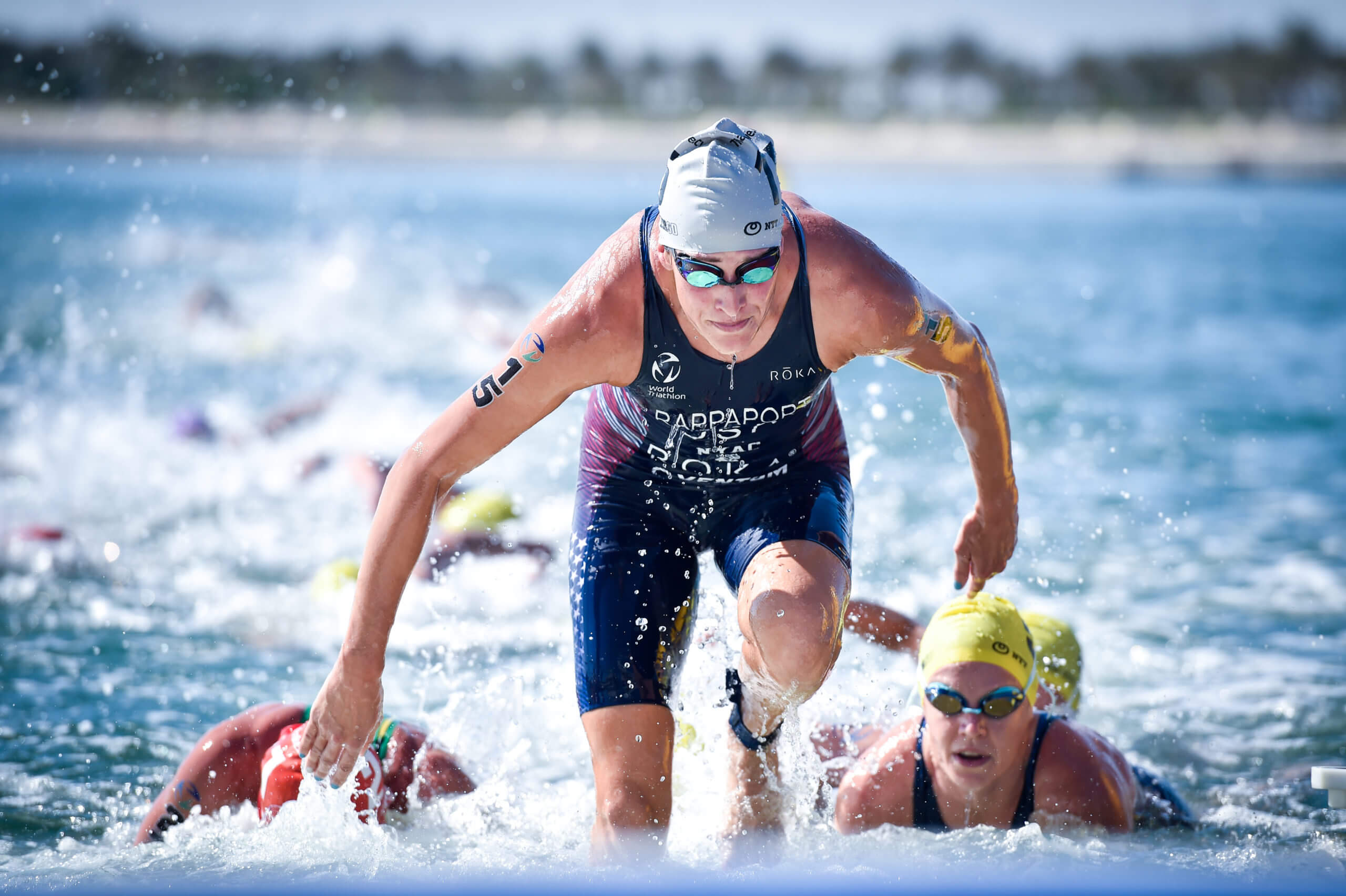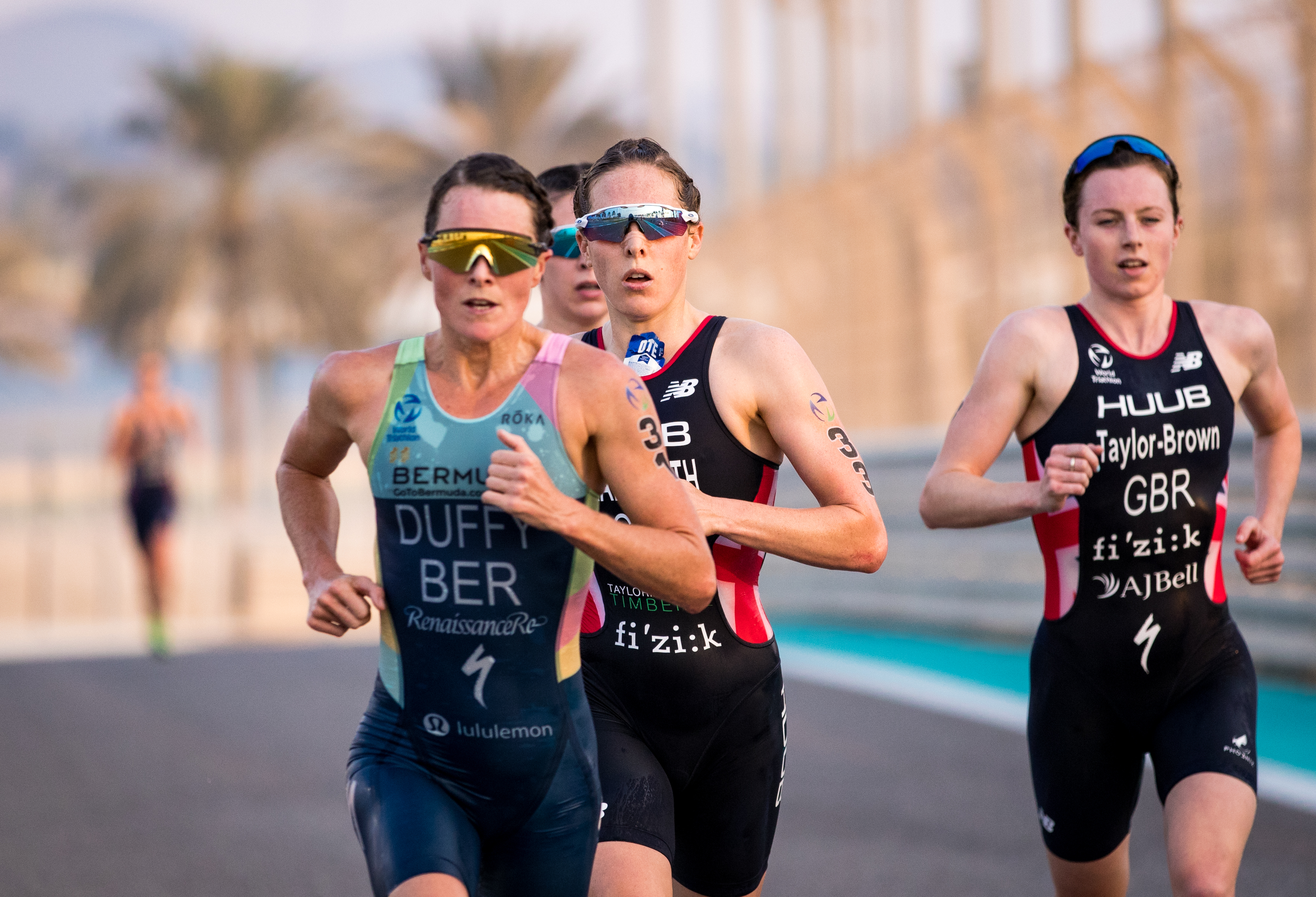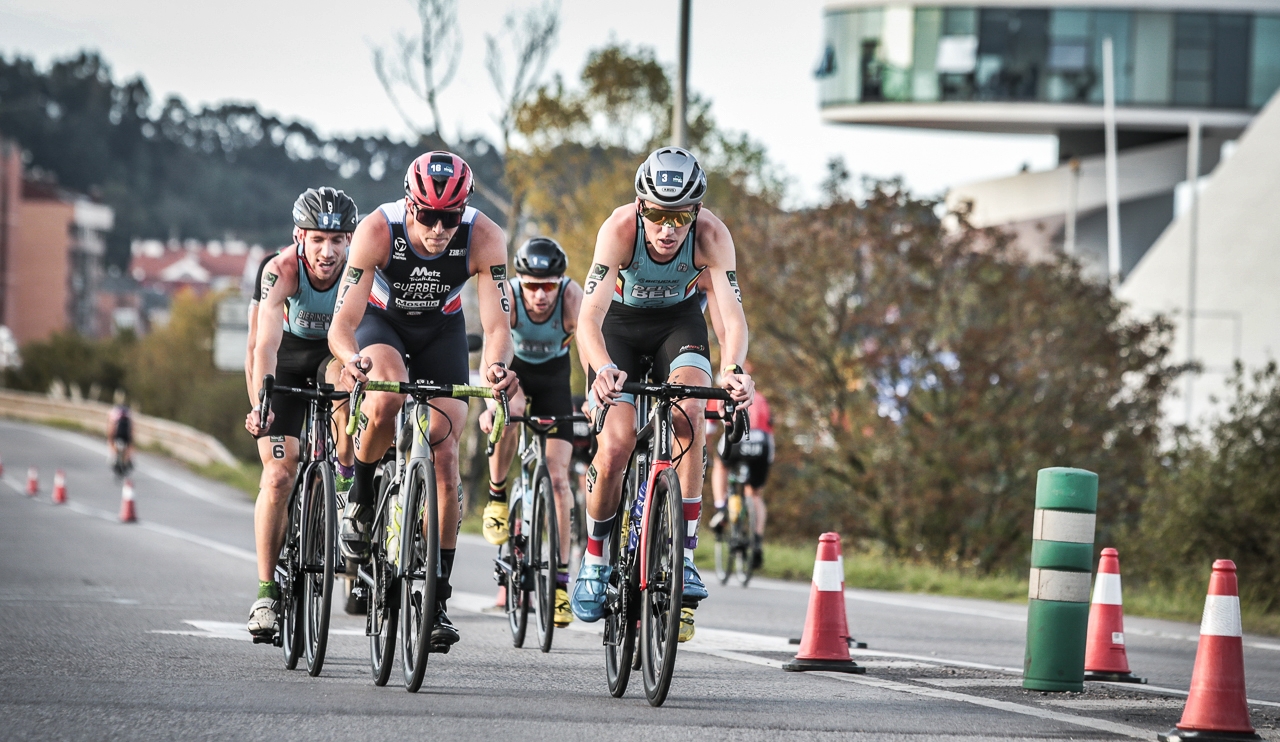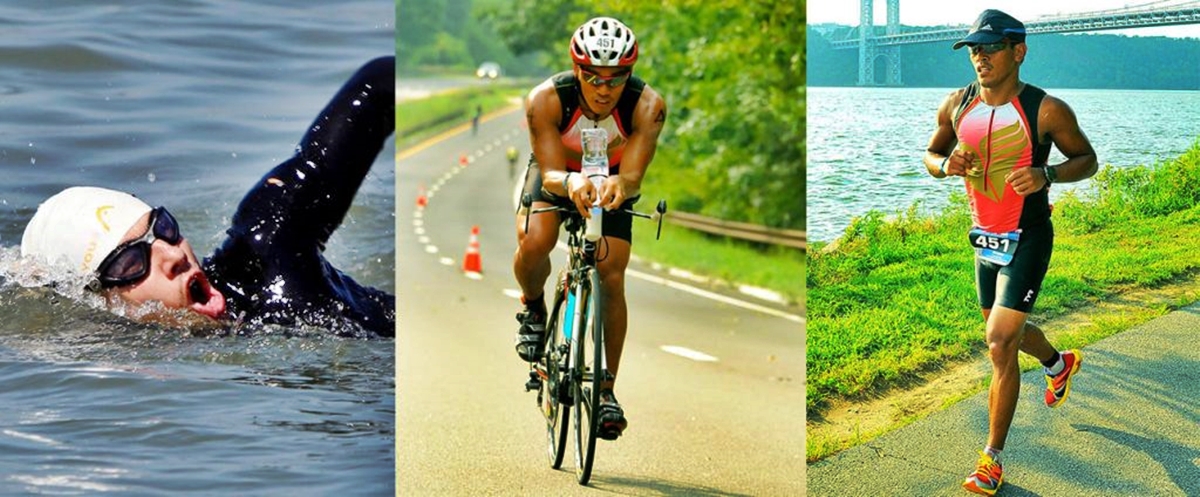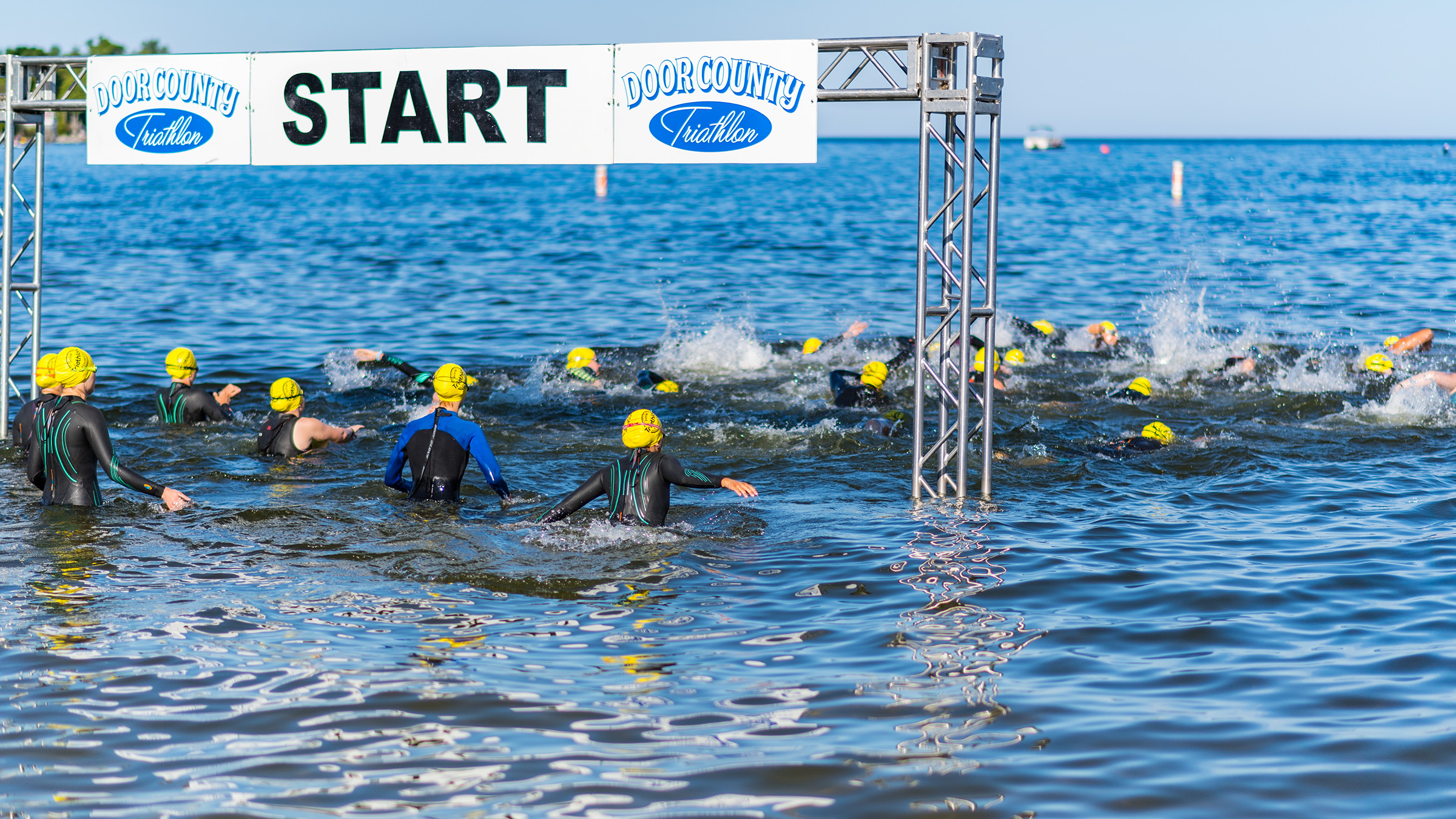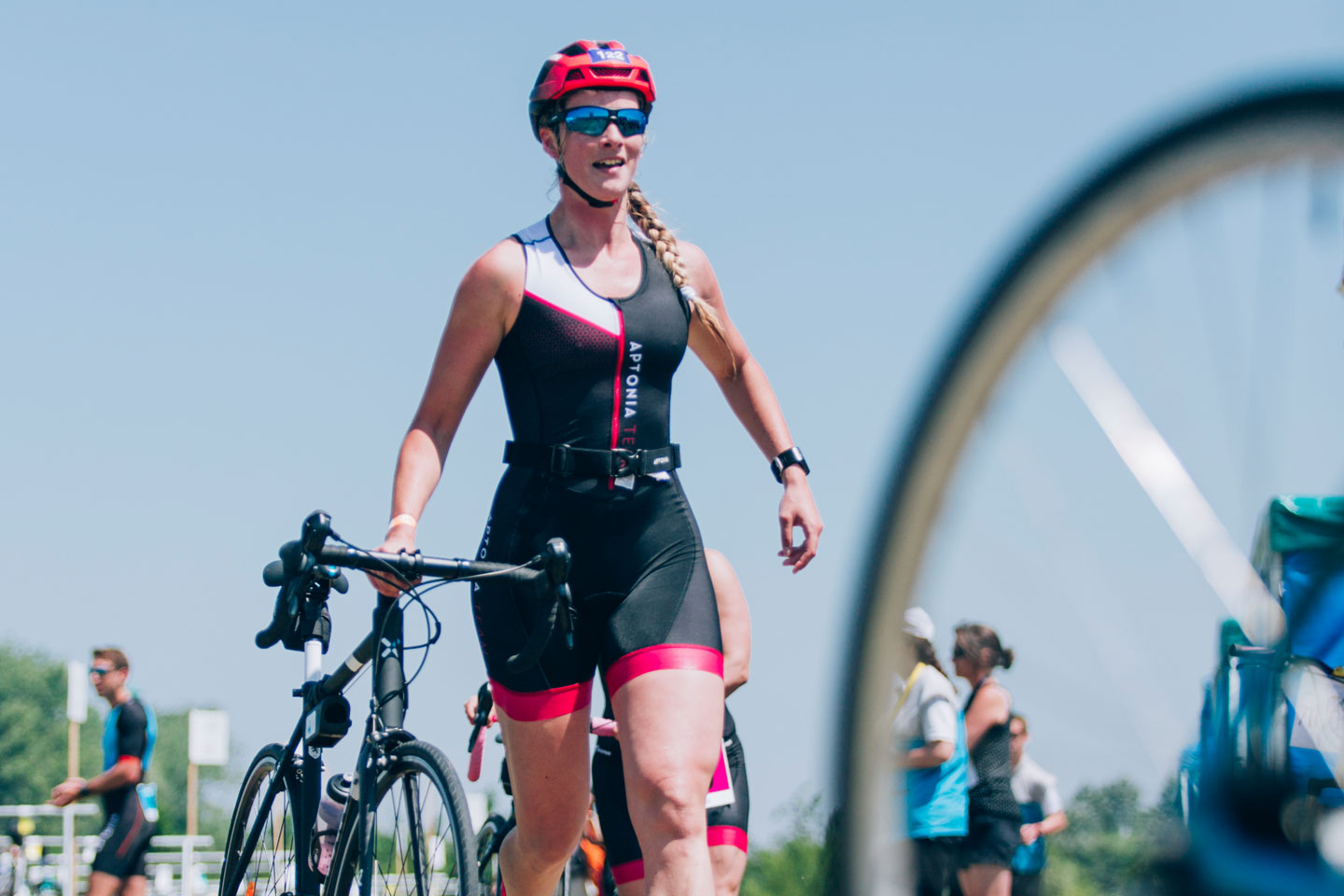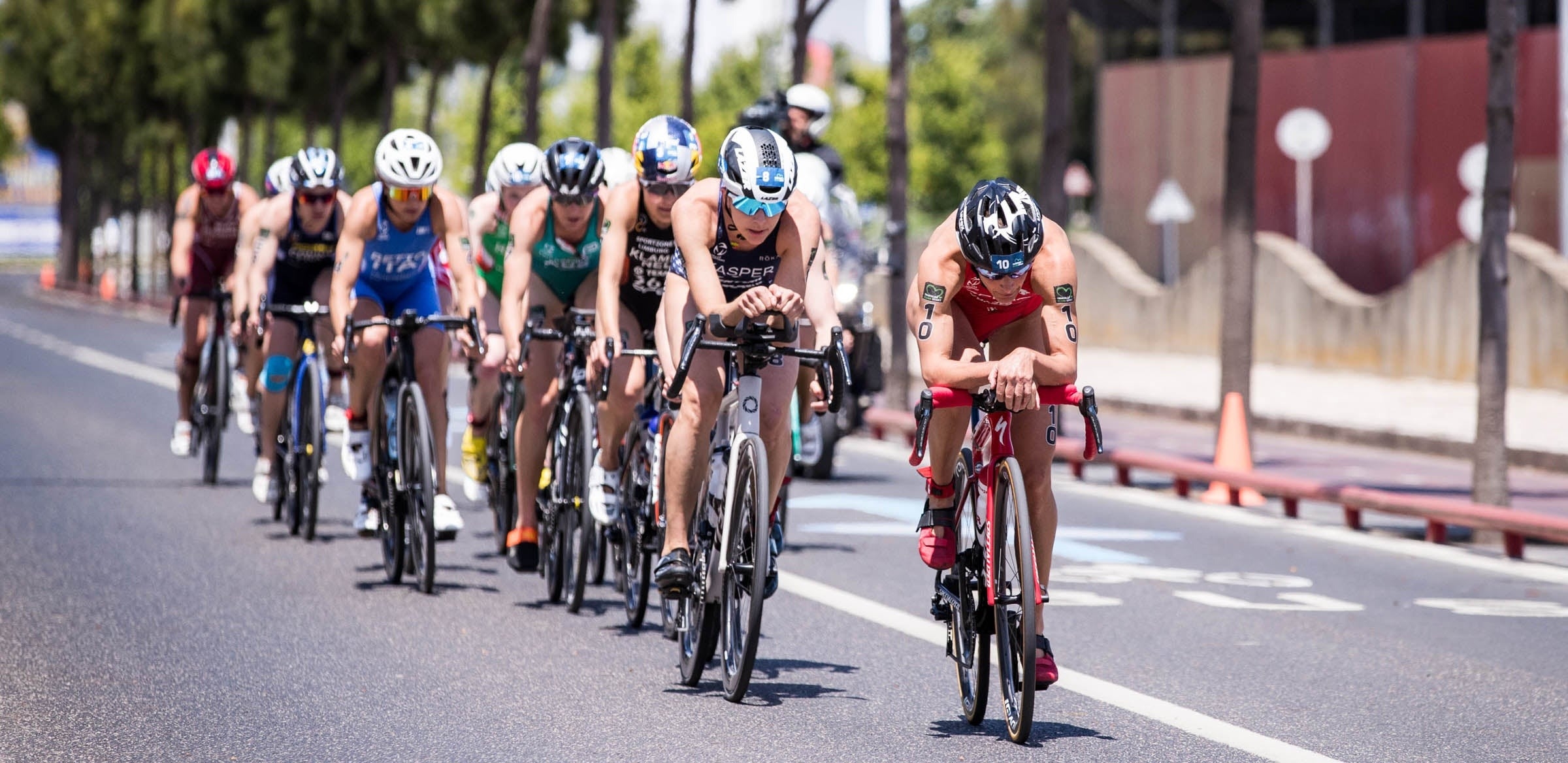

Featured
How Long To Train For A Sprint Triathlon
Modified: January 22, 2024
"Discover the perfect training duration for your sprint triathlon. Learn the essentials and get featured tips to prepare for the ultimate challenge."
Introduction
A sprint triathlon is a thrilling multi-sport event that combines swimming, cycling, and running into one exhilarating race. With its shorter distances and manageable training requirements, the sprint triathlon has become increasingly popular among athletes of all skill levels. Whether you’re a novice or a seasoned athlete looking to challenge yourself, training for a sprint triathlon can be a rewarding and transformative experience.
This article will guide you through the process of training for a sprint triathlon, offering valuable insights and tips to help you reach your goals. From understanding the basics of a sprint triathlon to developing an effective training schedule, we’ll cover all the essential aspects to set you up for success.
Before diving into the training details, it’s essential to have a clear understanding of what a sprint triathlon entails. In a sprint triathlon, participants typically swim around 750 meters (0.5 miles), cycle for about 20 kilometers (12.4 miles), and finish with a 5-kilometer (3.1 miles) run. These distances may vary slightly depending on the specific event, but they provide a general framework for the race.
Training for a sprint triathlon requires a balance of endurance, speed, strength, and mental toughness. You’ll need to develop proficiency in each discipline while also mastering the art of transitioning smoothly between them. Additionally, proper nutrition and hydration, as well as a well-planned race-day strategy, are crucial components of a successful sprint triathlon.
Throughout this article, we’ll explore various aspects of sprint triathlon training, including developing endurance, improving speed and power, incorporating strength and cross training, mastering efficient transitions, and enhancing swim, bike, and run skills. We’ll also delve into the importance of rest and recovery, managing pre-race jitters, and implementing effective nutrition and hydration strategies.
By following this comprehensive guide, you will be well-prepared to tackle the unique challenges of a sprint triathlon. Whether you’re aiming for a personal best time or simply aiming to cross the finish line with a smile on your face, this article will equip you with the knowledge and tools you need to thrive in your sprint triathlon journey.
Understanding the Basics of a Sprint Triathlon
Before you begin training for a sprint triathlon, it’s crucial to understand the fundamentals of this multi-sport event. A sprint triathlon consists of three disciplines: swimming, cycling, and running. Unlike its longer distance counterparts, such as Olympic or Ironman triathlons, a sprint triathlon is shorter in distance but equally demanding.
The swimming leg of a sprint triathlon usually takes place in a pool or open water, with a typical distance of around 750 meters (0.5 miles). It’s essential to practice open water swimming to acclimate yourself to the challenges of currents, waves, and unfamiliar surroundings. Additionally, honing your technique through drills and regular pool sessions will improve your efficiency and speed in the water.
The cycling portion of a sprint triathlon is typically 20 kilometers (12.4 miles) long. It’s important to have a reliable and well-maintained bike, whether it’s a road bike or a triathlon-specific bike. Familiarize yourself with the course terrain, if possible, to plan your strategy accordingly. Building endurance, improving cycling technique, and mastering gear shifting and bike handling skills are key components in this phase of training.
The final leg of a sprint triathlon is the run, which is usually a 5-kilometer (3.1 miles) distance. Developing a running routine, incorporating interval and endurance training, and focusing on proper form and breathing techniques are essential to maximize your running performance. Gradually increasing your running distances and adding brick workouts (combining two or more disciplines) will prepare your body for the unique demands of the triathlon run.
In addition to the individual disciplines, mastering the art of transitions is crucial in a sprint triathlon. Transitions refer to the time between each leg when you switch from swimming to cycling (T1) and from cycling to running (T2). Efficient transitions can save precious minutes from your overall race time. Practicing quick and smooth transitions, arranging your gear strategically, and visualizing the process beforehand will ensure a seamless transition experience on race day.
Having a clear understanding of the basics of a sprint triathlon will help you approach your training with focus and purpose. By breaking down the different aspects of the event and preparing yourself mentally and physically for each discipline, you’ll be well-equipped to tackle the exciting challenge that lies ahead.
Setting Your Training Schedule
When embarking on your sprint triathlon training journey, it’s crucial to create a well-structured and realistic training schedule. This will help you stay consistent, manage your time effectively, and gradually build your fitness level.
The first step in setting your training schedule is to determine the duration of your training plan. Most sprint triathlon training plans range from 8 to 12 weeks. Choose a length that aligns with your current fitness level and the time you have available to commit to training.
Next, consider your weekly availability and commitments. Look at your work schedule, family responsibilities, and any other obligations you have. Identify the days and times that you can dedicate to training. Aim for a minimum of four training days per week, allowing for a mix of disciplines and recovery days.
Once you have established your training days, focus on balancing the three disciplines of swimming, cycling, and running throughout the week. Aim for at least one workout in each discipline per week, gradually increasing the duration and intensity as your training progresses.
It’s also important to incorporate cross-training and strength training into your schedule. Cross-training activities such as yoga, Pilates, or strength training exercises help to improve overall strength, flexibility, and prevent injuries. Aim to incorporate one or two cross-training sessions per week.
As you set your training schedule, be mindful of your current fitness level and any previous experience with the disciplines. If you are new to swimming or cycling, allocate more time for those disciplines in the beginning. If running is your strength, you can devote slightly less time to it and focus on improving your weaker areas.
Remember to include rest days in your training schedule. Rest is an essential component of any training plan as it allows your body to recover and rebuild. Plan for at least one or two rest days per week to prevent overtraining and optimize your performance.
Flexibility is key when setting your training schedule. Life happens, and unforeseen circumstances may arise. Be prepared to adjust your training plan if needed, whether it’s swapping workout days or modifying your training sessions. It’s better to adapt and stay consistent in the long run than to stick rigidly to a plan that becomes unmanageable.
Lastly, listen to your body and pay attention to any signs of fatigue or injury. If you need to take an extra rest day or scale back on the intensity, do so. It’s better to prioritize your well-being and prevent injury than to push through and risk long-term setbacks.
By setting a well-balanced and realistic training schedule, you’ll set yourself up for success in your sprint triathlon journey. Consistency, patience, and adaptability are key as you work towards achieving your goals and crossing that finish line with confidence.
Assessing Your Current Fitness Level
Before diving into a sprint triathlon training program, it’s important to assess your current fitness level. Understanding your strengths and weaknesses will help you tailor your training plan to your specific needs and set realistic goals for yourself.
There are several aspects to consider when assessing your fitness level for a sprint triathlon. Here are some key areas to evaluate:
Swimming: Assess your swimming ability and comfort level in the water. Determine if you can comfortably swim the required distance of around 750 meters (0.5 miles). It’s also helpful to evaluate your swimming technique and efficiency. Consider enlisting the help of a swim coach or joining a swimming group to receive professional guidance and feedback.
Cycling: Evaluate your cycling skills and endurance. Determine if you are comfortable riding a bike for extended periods and if you have the necessary bike-handling skills. Assess your average speed and ability to climb hills or handle different terrains. Consider tracking your equipment to ensure it is in good working order and properly fitted to your body.
Running: Assess your running fitness and endurance. Determine if you can comfortably run the required distance of 5 kilometers (3.1 miles). Consider your running pace and ability to maintain a steady pace over time. It’s also important to evaluate your running form and any potential weaknesses or imbalances that may need attention.
In addition to assessing the individual disciplines, consider your overall fitness level. Evaluate your cardiovascular endurance, strength, and flexibility. Assess your ability to handle the demands of all three disciplines consecutively.
Through these assessments, you’ll gain a clear understanding of where you currently stand in terms of fitness and skill level. This self-awareness will guide you in setting realistic goals and designing a training plan that addresses your specific needs.
Keep in mind that everyone’s starting point is different, and that’s okay. Don’t compare yourself to others or feel discouraged if you feel like you have a long way to go. Remember that this is your journey, and progress is made one step at a time.
Consider consulting with a coach or trainer who specializes in triathlon training. They can provide professional guidance, conduct more formal assessments, and help you create a customized training plan. They can also offer valuable insights on improving technique, building strength, and preventing injuries.
By assessing your current fitness level, you’ll have a solid foundation for developing a training plan that is both challenging and achievable. With realistic goals in mind, you’ll be on your way to becoming a confident and successful sprint triathlete.
Building Endurance
Building endurance is a critical component of training for a sprint triathlon. It involves gradually increasing your cardiovascular and muscular stamina, allowing you to sustain a higher level of effort throughout each discipline of the race. By focusing on endurance, you’ll be able to tackle the distances required for the swim, bike, and run with confidence and ease.
To build endurance effectively, it’s important to follow a progressive training plan. Here are some strategies to help you improve your endurance:
- Long Slow Distance (LSD) Training: Incorporate long, steady sessions into your training schedule. These sessions should be performed at a comfortable pace, allowing you to improve your cardiovascular fitness without pushing too hard. Gradually increase the distance of each discipline over time to challenge your endurance levels.
- Interval Training: Incorporate interval training into your workouts to improve both your aerobic and anaerobic endurance. Intervals involve alternating between periods of high-intensity effort and recovery. For example, during a swim session, you could perform sets of 100-meter sprints followed by a short rest interval. Intervals help to improve your overall speed and endurance.
- Brick Workouts: Incorporate brick workouts into your training routine. A brick workout involves completing two or more disciplines consecutively, simulating the transition experience during a triathlon. For example, you could swim for a set distance, followed immediately by a bike ride and then a run. This type of training helps your body adapt to the unique demands of a sprint triathlon by challenging your muscular and cardiovascular endurance.
- Progressive Overload: Gradually increase the duration and intensity of your workouts as your fitness improves. This principle of progressive overload allows your body to adapt and become more resilient over time. However, it’s important to listen to your body and avoid pushing yourself too hard. Strive for a gradual and sustainable increase in workload.
- Consistency: Consistency is key when building endurance. Aim to train regularly, sticking to your training plan as closely as possible. Consistent training allows your body to adapt and make long-term progress. Even on days when you may not feel motivated, committing to a shorter, lighter workout is better than skipping training altogether.
- Rest and Recovery: Building endurance requires a balance of training and rest. Allow for proper recovery between training sessions to avoid overtraining and reduce the risk of injury. Plan rest days into your training schedule and prioritize sleep to allow your body to repair and rebuild.
Building endurance is a gradual process that requires patience and dedication. The key is to consistently challenge yourself while allowing your body time to adapt and recover. By incorporating these strategies into your training plan, you’ll be well on your way to building the endurance necessary for a successful sprint triathlon.
Improving Speed and Power
In addition to building endurance, improving speed and power is essential for enhancing your performance in a sprint triathlon. By focusing on speed and power training, you’ll be able to increase your overall race pace, optimize your efficiency, and push yourself to new levels of performance.
Here are some strategies to help you improve your speed and power:
- Interval Training: Incorporate high-intensity interval training (HIIT) into your workouts. HIIT involves alternating between short bursts of maximal effort and recovery periods. For example, during a run, you could sprint for 30 seconds followed by a jog or walk for 60 seconds. HIIT sessions improve both your anaerobic and aerobic capacity, enabling you to sustain a faster pace during the race.
- Fartlek Training: Fartlek, which means “speed play” in Swedish, involves unstructured intervals of varying intensities. During a training run or ride, mix in periods of increased effort, such as sprinting to a landmark ahead or pushing harder during a specific segment of the route. Fartlek training helps develop your ability to change pace and maintain speed throughout the race.
- Hill Training: Incorporate hill repeats into your training routine. Find a challenging incline and perform multiple repetitions of running or cycling up the hill at a high intensity. Hill training improves leg strength, power, and speed. It also enhances your mental toughness by tackling tough terrain.
- Strength Training: Include strength training exercises that focus on power and explosiveness. Squats, lunges, deadlifts, plyometric exercises, and resistance band exercises are all beneficial for building power in your lower body. Additionally, core exercises such as planks and Russian twists can improve your stability and overall athletic performance.
- Technique Work: Focus on refining your technique in each discipline. Improving your stroke efficiency in swimming, optimizing your pedal stroke in cycling, and perfecting your running form can all contribute to increased speed. Consider seeking guidance from a coach or joining technique-based classes to hone your skills.
- Visualization: Mental imagery is a powerful tool in improving speed and power. Visualize yourself performing at your peak during the race. Picture yourself moving effortlessly, maintaining a strong and efficient pace, and crossing the finish line with confidence. Visualization can help improve your mental focus and drive during training and on race day.
It’s important to incorporate speed and power training sessions into your overall training plan. However, balance is key. Avoid overdoing high-intensity sessions, as this can increase the risk of injury and hinder long-term progress. Remember to listen to your body, recover adequately, and gradually increase the intensity and volume of your speed workouts.
Additionally, remember that speed and power should be developed in conjunction with building endurance. Finding the right balance between speed, power, and endurance training will help you achieve the optimal performance in your sprint triathlon.
By incorporating these strategies into your training plan and consistently pushing yourself outside your comfort zone, you’ll be able to improve your speed and power, giving you the competitive edge you need to excel in your sprint triathlon.
Incorporating Strength and Cross Training
A well-rounded training program for a sprint triathlon includes not only swim, bike, and run workouts but also strength and cross training. Incorporating these elements into your routine will help you improve overall performance, prevent injuries, and enhance your strength and endurance in the three disciplines of the triathlon.
Strength Training:
Strength training plays a significant role in a sprint triathlon as it helps build muscular strength, power, and stability. Here are some key points to consider when incorporating strength training:
- Focus on Functional Movements: Perform exercises that mimic the movements and muscles used in swimming, cycling, and running. Examples include lunges, squats, deadlifts, push-ups, and pull-ups. These compound movements engage multiple muscle groups, improving overall strength and stability.
- Schedule Regular Strength Sessions: Aim to include strength training sessions two to three times a week. Give attention to all major muscle groups, including the legs, core, back, and upper body. Allocate at least 24 hours of recovery between strength sessions to allow your muscles to repair and grow stronger.
- Progressive Overload: Gradually increase the intensity, weight, and repetitions of your exercises over time to challenge your muscles and encourage adaptation. Begin with lighter weights and focus on proper form before adding more weight.
- Focus on Core Strength: Building a strong core is vital for maintaining stability and proper body alignment throughout the race. Include exercises such as planks, Russian twists, and bicycle crunches to strengthen your core muscles.
- Consider Working with a Trainer: If you’re new to strength training or want to refine your technique, consider working with a qualified trainer who has experience in triathlon-specific strength training. They can provide guidance, personalized exercises, and ensure you’re performing movements correctly to maximize your results.
Cross Training:
In addition to strength training, cross training activities provide a range of benefits for sprint triathlon training. Here’s why cross training is valuable:
- Injury Prevention: Engaging in non-impact activities such as swimming, cycling, yoga, and Pilates helps reduce the risk of overuse injuries associated with repetitive running motions.
- Active Recovery: Cross training allows you to stay active while giving certain muscles a break from the impact of running. Engaging in low-impact activities on rest days helps improve blood circulation, aids recovery, and reduces muscle soreness.
- Muscle Balance and Flexibility: Cross training helps improve overall muscle balance and flexibility, enhancing your performance and reducing the risk of injury. Activities like yoga and Pilates can improve flexibility, while cycling and swimming offer a balance by engaging different muscles than those used in running.
- Improved Mental Focus: Cross training activities can provide a mental break from the triathlon training routine, helping to reduce mental fatigue and increase motivation.
- Variety and Fun: Cross training introduces variety into your training routine, keeping things fun and interesting. Trying new activities not only prevents boredom but also gives you a chance to explore different aspects of fitness and discover new passions.
When incorporating cross training, aim to include activities that complement your triathlon training. For example, swimming and cycling can be used as cross training if you’re primarily a runner. However, it’s essential to strike a balance and avoid overdoing it. Cross training sessions should not interfere with your primary swim, bike, and run workouts.
By incorporating strength training and cross training into your program, you’ll develop a well-rounded fitness base that supports your performance in a sprint triathlon. With increased strength, power, and muscular endurance, you’ll be better equipped to conquer the challenges of the race and achieve your goals.
Developing Efficient Transitions
Transitions play a crucial role in a sprint triathlon as they can make or break your race time. Efficient transitions can save valuable seconds or even minutes, allowing you to maintain momentum and gain a competitive edge. Here are some key tips to help you develop efficient transitions:
- Practice, Practice, Practice: Transition practice is essential. Set up a transition area at home or at your training location and simulate the transition process. Practice moving from one discipline to another swiftly and smoothly. This includes stripping off your wetsuit (if applicable), putting on cycling shoes, donning a helmet, and switching from cycling to running gear.
- Arranging Your Gear Strategically: Lay out your gear in a logical and organized manner in the transition area. Place your bike shoes and helmet in a way that allows for easy access and quick changes. Familiarize yourself with the layout of the transition area beforehand to reduce confusion on race day.
- Visualize the Process: Mentally rehearse the transition process to familiarize yourself with the sequence of movements. Visualize smoothly and efficiently moving from one discipline to the next. This mental preparation helps improve focus and reduces potential mistakes during the transition.
- Use Elastic Laces: Consider using elastic laces for your running shoes. Elastic laces allow for quick and easy slip-on and eliminate the need for tying shoelaces during the transition. This small adjustment can save precious seconds.
- Know the Rules: Familiarize yourself with the specific rules and regulations of the race regarding transitions. Some races may have specific guidelines on how your gear should be set up or any limitations on assistance from others. Understanding these rules beforehand will save you from potential penalties or disqualification.
- Eliminate Wasted Movements: Streamline your transition by minimizing unnecessary movements. For example, leave your helmet unfastened on your handlebars during the bike leg so that you can easily slip it on as you approach the transition area. It’s also helpful to practice mounting and dismounting your bike smoothly.
- Be Efficient, Not Hasty: Strive for efficiency in transitions, but also maintain composure and take a few seconds to ensure that you have everything you need before moving on to the next discipline. Double-check that you haven’t left any essential gear behind or forgotten any nutrition or hydration items.
- Relax and Stay Focused: Transition areas can be chaotic, especially during a race. Stay calm and composed, block out distractions, and focus on your own process. The key is to maintain a clear mind and execute each transition step with purpose.
Remember, developing efficient transitions takes practice and repetition. Incorporate transition workouts regularly into your training plan to refine your technique and improve your speed and efficiency. By optimizing your transition process, you’ll be able to seamlessly move from one discipline to the next, maximizing your race performance.
Mastering the Swim Leg
The swim leg of a sprint triathlon can be intimidating, especially for those who are new to open water swimming. However, with the right techniques and training, you can master the swim leg and emerge from the water with confidence. Here are some key points to consider when preparing for the swim leg:
- Open Water Practice: If possible, practice swimming in open water before the race. This will help you acclimate to the challenges of swimming in unfamiliar environments, such as dealing with currents, waves, and potential crowding. Seek out a local open water swimming group or find a designated open water swim area to gain experience and build confidence.
- Swim Technique and Efficiency: Focus on improving your swim technique to maximize efficiency and conserve energy during the swim leg. Work on proper body alignment, effective breathing techniques, and a strong and steady swim stroke. Consider working with a swim coach to receive professional guidance and feedback on your technique.
- Interval Training: Incorporate distance-focused interval training into your swim workouts. This involves swimming shorter, intense bursts followed by brief recovery periods. This type of training helps improve your speed and endurance, preparing you for the intensity of the swim leg during the race.
- Open Water Skills: Train specifically for open water swimming by practicing skills such as sighting (lifting your head to navigate toward a reference point) and drafting (swimming close behind another swimmer to reduce resistance). These skills will help you navigate and avoid unnecessary detours during the race.
- Practice Transitions: Incorporate swim-to-bike (T1) transitions into your training sessions. Practice quickly and efficiently transitioning from the swim to the cycling leg. This includes removing your wetsuit (if applicable), putting on your cycling gear, and getting ready for the next discipline in a timely manner.
- Prepare for Race Conditions: Familiarize yourself with the specific race conditions, including water temperature, currents, and potential obstacles. Consider training in similar conditions leading up to the race to prepare your body and mind for the specific challenges you may face.
- Simulate Race Day Scenarios: Practice swimming in a crowded environment to simulate race day conditions. This will help you become comfortable with close proximity to other swimmers and reduce anxiety. It’s also a good opportunity to practice breathing and sighting techniques under slightly stressful conditions.
- Build Distance Gradually: If swimming is new to you, gradually build up your distance over time. Start with shorter workouts and gradually increase the distance as your fitness improves. Remember to focus on technique and efficiency as you increase your swimming distance.
When it comes to the swim leg, it’s important to remain calm and maintain a steady pace. Start closer to the back of the pack if you’re not confident in a mass start, allowing yourself some space to find your rhythm. Remember to breathe regularly and sight periodically to ensure you’re heading in the right direction.
Lastly, always prioritize safety during open water swimming. Swim with a buddy whenever possible and be mindful of your surroundings. If you feel uncomfortable or overwhelmed at any point during the swim leg, don’t hesitate to seek assistance from a race marshal or support personnel.
With consistent training and a focus on technique, you can master the swim leg of a sprint triathlon. By building confidence and gaining competence in open water swimming, you’ll be well on your way to a successful race.
Enhancing Your Cycling Skills
As the longest leg of a sprint triathlon, the cycling portion requires both physical fitness and technical proficiency. Enhancing your cycling skills will not only improve your performance but also boost your confidence on race day. Here are some key points to consider when aiming to enhance your cycling skills:
- Bike Handling Skills: Practice bike handling skills, such as cornering, shifting gears efficiently, and braking smoothly. Familiarize yourself with the different hand positions on the handlebars to optimize control and stability. By improving your bike handling skills, you’ll feel more confident and be able to navigate varied terrain with ease.
- Interval Training: Incorporate interval training into your cycling workouts to improve both your endurance and power. Interval sessions involve alternating between periods of high-intensity effort and low-intensity recovery. This type of training helps simulate race conditions and prepares your body for the intensity of the cycling leg.
- Hill Training: Focus on hill training to build strength and improve your climbing skills. Seek out hills in your training routes and practice maintaining a steady cadence while tackling both short, steep hills and longer, gradual climbs. Incorporate hill repeats and interval workouts to enhance your ability to climb with power and efficiency.
- Pedal Stroke Efficiency: Work on developing a smooth and efficient pedal stroke. Focus on applying power throughout the entire pedal revolution, rather than just pushing down on the pedals. This will enable you to maintain a consistent effort and optimize your power output. A cycling coach or a bike fit specialist can provide guidance on improving your pedal stroke.
- Group Riding: Join a local cycling group or team to gain experience and confidence in group riding. Group rides provide an opportunity to learn drafting techniques, practice riding in close proximity to others, and improve your overall bike handling in a dynamic environment. Observe the behavior and communication among experienced cyclists in the group to enhance your own skills.
- Nutrition and Hydration on the Bike: Practice fueling and hydrating during your training rides to develop a strategy that works best for you. Experiment with different energy gels, bars, and electrolyte drinks to find what sustains your energy levels and keeps you properly hydrated throughout the ride. Learning to consume nutritional elements on the bike without affecting your speed or balance is essential for race day success.
- Brick Workouts: Incorporate brick workouts into your training routine to adapt to the feeling of cycling after swimming and running. By practicing the transition from running to cycling, you’ll improve your ability to quickly adjust your muscles and maintain a smooth cycling rhythm coming off the run leg.
- Bike Maintenance: Regularly maintain your bike to ensure it functions properly and performs optimally. Keep your tires properly inflated, lubricate the chain, and periodically check for loose bolts and worn-out components. A bike in good working condition is safer and more efficient, allowing you to focus on your cycling skills without any mechanical issues.
It’s important to spend time in the saddle and accumulate miles during your training. Gradually increase the duration and distance of your rides, incorporating a mix of terrain and intensity levels. By consistently working on your cycling skills and incorporating targeted workouts, you’ll see significant improvements in both your speed and endurance.
Remember to always prioritize safety while cycling. Wear a helmet, follow traffic rules, and be aware of your surroundings. Invest in a good pair of bike shorts and consider using padded gloves to increase comfort and reduce the risk of developing overuse injuries.
Whether you’re a seasoned cyclist or new to the sport, enhancing your cycling skills will positively impact your performance in a sprint triathlon. With practice, dedication, and a focus on technique, you’ll become a stronger, more confident cyclist, ready to conquer the cycling leg of your triathlon.
Perfecting Your Running Technique
Running is a key component of a sprint triathlon, and improving your running technique can make a significant difference in your performance. By focusing on proper form, efficient stride mechanics, and effective breathing, you can enhance your speed, endurance, and overall running efficiency. Here are some key points to consider when perfecting your running technique:
- Posture and Alignment: Maintain an upright posture with your head aligned with your spine. Avoid slouching or leaning forward excessively. Engage your core muscles to stabilize your body, allowing for efficient energy transfer and optimal running form.
- Footstrike: Aim for a midfoot or forefoot strike rather than landing on your heels. This minimizes braking forces and allows for a more efficient transfer of energy. Avoid overstriding, as it can lead to inefficient running and higher injury risk. Instead, aim for a quick and light turnover of your feet.
- Arm Swing: Utilize a controlled and relaxed arm swing. Your arms should move forward and backward, not across your body. Keep your elbows bent at around a 90-degree angle and swing them naturally in sync with your leg movements. A strong and efficient arm swing helps to maintain balance and propels you forward.
- Breathing: Focus on deep belly breathing rather than shallow chest breathing. Take slow, deep breaths to bring in as much oxygen as possible. Find a rhythm that suits your pace and helps you maintain a relaxed state of breathing throughout your run.
- Cadence: Aim for a high cadence (number of steps per minute) to develop a quicker and more efficient running stride. Strive for a cadence of around 180 steps per minute, which helps reduce the risk of overstriding and promotes a more efficient running form.
- Core Strength and Stability: Develop a strong core to improve stability and maintain proper alignment during running. Incorporate exercises like planks, Russian twists, and supermans into your strength training routine to enhance your core strength, which aids in maintaining a stable and efficient running posture.
- Flexibility and Mobility: Incorporate stretching exercises and mobility drills into your warm-up and cool-down routines. Focus on areas like the hips, hamstrings, and calves to improve range of motion and prevent muscle imbalances. Flexibility helps maintain proper running form and reduces the risk of injury during the run leg of your triathlon.
- Hill Training and Interval Workouts: Include hill training and interval workouts in your training regimen to build strength, speed, and endurance. Training on hilly terrain and incorporating intervals will help you develop the power and mental resilience needed to tackle varied race conditions.
- Gradual Progression: Gradually increase your running distance and intensity to allow your body to adapt and reduce the risk of overuse injuries. Avoid sudden increases in mileage or intensity. Follow a structured training plan that includes a mix of endurance runs, speed workouts, and rest days to promote proper recovery and progress.
Video analysis or working with a running coach can also provide valuable insights into your running form and help identify areas for improvement. They can offer specific exercises and drills tailored to your individual needs.
Remember, perfecting your running technique is a continuous process. Focus on one aspect at a time and be patient with yourself. Regular practice and feedback from knowledgeable sources will help you make strides in refining your running technique, ultimately improving your sprint triathlon performance.
Balancing Rest and Recovery
Rest and recovery are essential components of any training program, including sprint triathlon training. Balancing rest and recovery is crucial to optimize performance, prevent overtraining, and reduce the risk of injuries. It allows your body to adapt and grow stronger, ensuring that you’re ready to tackle the demands of the race. Here are some key points to consider when maintaining a balance between rest and recovery:
- Rest Days: Schedule dedicated rest days in your training plan. These are days when you refrain from intense workouts and allow your body to recuperate. Rest days help prevent physical and mental burnout, enhancing long-term performance. Use this time to engage in active recovery activities such as gentle stretching, foam rolling, or low impact exercises like swimming or walking.
- Quality Sleep: Prioritize sleep as a vital part of your recovery routine. Aim for 7-9 hours of quality sleep each night to support muscle repair, hormone regulation, and overall physical and mental well-being. Establish a bedtime routine, create a conducive sleep environment, and limit exposure to electronics and other stimulating activities before bed.
- Listen to Your Body: Pay attention to your body’s signals and adjust your training plan accordingly. If you’re feeling excessively fatigued, experiencing persistent soreness or pain, or your motivation is lacking, it may be a sign that you need additional rest or a lighter training load. Skipping a workout or taking an extra rest day can be more beneficial in the long run than pushing through excessive fatigue or discomfort.
- Recovery Techniques: Incorporate recovery techniques into your routine to aid in muscle repair and reduce soreness. These may include foam rolling, massage, stretching, or using compression garments. Experiment with different techniques to find what works best for your body and helps you recover more effectively.
- Nutrition and Hydration: Proper nutrition and hydration play a crucial role in recovery. Refuel your body with balanced meals that include a combination of carbohydrates, protein, and healthy fats. Consume foods rich in antioxidants and anti-inflammatory properties to support recovery and reduce muscle inflammation. Stay hydrated throughout the day to help flush out metabolic waste and aid in the recovery process.
- Active Recovery: Incorporate active recovery activities into your training plan. Gentle exercises such as walking, swimming, or easy cycling can promote blood circulation, aid in muscle recovery, and help you maintain a consistent training routine without placing excessive stress on your body.
- Periodization: Implement a periodization approach to your training, which involves planned variations in intensity and volume throughout different phases. This allows for targeted training adaptations and periods of higher and lower intensity, allowing for proper recovery and overall progression.
- Mental and Emotional Recovery: Recognize the importance of mental and emotional recovery alongside physical rest. Engaging in relaxation techniques, meditation, or participating in activities you enjoy outside of triathlon can help reduce stress and enhance overall well-being.
Remember, recovery is not a sign of weakness but rather a crucial part of the training process. By honoring rest and recovery, you’ll allow your body to recharge and reap the benefits of your hard work. Finding the right balance between training and recovery will help you stay healthy, motivated, and improve your performance on race day.
Managing Pre-race Jitters
Pre-race jitters are a common experience for athletes of all levels. The anticipation and nervousness leading up to a sprint triathlon can be overwhelming. However, with the right mindset and strategies, you can effectively manage pre-race jitters and perform at your best on race day. Here are some key points to consider when it comes to managing pre-race jitters:
- Embrace the Nerves: Instead of trying to eliminate or suppress your jitters, acknowledge them as a natural response to the excitement and challenge of the race. Embrace the adrenaline and use it to your advantage, channeling the nervous energy into focus and motivation.
- Visualize Success: Incorporate visualization techniques into your race preparation. Take time to vividly imagine yourself going through each leg of the triathlon with confidence and ease. Visualize crossing the finish line and experiencing the sense of accomplishment, allowing yourself to feel the emotions associated with achieving your goals.
- Stick to Your Routine: Maintain your established training routine and avoid making sudden changes in the days leading up to the race. This familiarity will help create a sense of stability and confidence. Don’t obsess over new strategies or last-minute training tweaks that may only add to your anxiety.
- Be Prepared: Ensure that you’re well-prepared for the race by organizing all the necessary gear and equipment ahead of time. Create a checklist and double-check everything the night before. Knowing that you’re fully prepared will give you peace of mind and alleviate some of the pre-race anxiety.
- Focus on What You Can Control: Redirect your attention to the aspects that you have control over, such as your training, nutrition, and race strategy. Concentrate on executing your race plan to the best of your abilities, rather than worrying about external factors that are out of your control.
- Break the Race into Smaller Goals: Instead of fixating on the entire race distance, break it down into smaller, manageable goals. Focus on reaching each transition point or landmark along the course, giving yourself mini-accomplishments to celebrate throughout the race.
- Positive Self-Talk: Replace negative or self-doubting thoughts with positive affirmations and encouraging self-talk. Remind yourself of your training, preparation, and the progress you’ve made so far. Repeat empowering mantras or use encouraging phrases to boost your confidence and shift your mindset to a more positive outlook.
- Seek Support: Surround yourself with a supportive network of friends, family, or fellow athletes who can provide encouragement and understanding. Share your pre-race jitters with them and seek their reassurance and guidance. Sometimes, discussing your concerns with someone who understands can offer valuable perspective and help alleviate anxious feelings.
- Relaxation Techniques: Incorporate relaxation techniques into your pre-race routine to calm your mind and body. Deep breathing exercises, meditation, progressive muscle relaxation, or gentle stretching can help reduce tension and promote a state of calmness before the race.
- Enjoy the Experience: Remember why you signed up for the sprint triathlon – to challenge yourself, grow as an athlete, and have fun. Embrace the entire journey, including the nervous anticipation leading up to the race. Allow yourself to enjoy the process and savor the unique experience of participating in a triathlon.
It’s normal to feel pre-race jitters, but with these strategies, you can manage those nerves and perform at your best on race day. Use the excitement and adrenaline to your advantage, maintain a positive mindset, and trust in your preparation. Remember, every triathlete experiences pre-race jitters, and it’s how you manage them that can make a difference in your performance and overall experience.
Nutrition and Hydration Strategies
Nutrition and hydration play a critical role in your performance and overall well-being during a sprint triathlon. Proper fueling and hydration strategies are essential to sustain your energy levels, support muscle function, and ensure optimal performance. Here are key points to consider when it comes to nutrition and hydration strategies:
- Pre-Race Meal: Consume a balanced meal rich in complex carbohydrates, lean proteins, and healthy fats several hours before the race. This meal should be easily digestible and low in fiber to avoid any potential gastrointestinal discomfort during the race. Experiment in training to find the foods that work best for you and give you sustained energy.
- Hydration: Stay well-hydrated in the days leading up to the race. On race day, start with a hydrating beverage and sip on water or a sports drink throughout the event to maintain hydration. Monitor your urine color as a general indicator of hydration status – light yellow is typically a good sign of adequate hydration.
- Race Day Fueling: During the race, consume carbohydrates in easily digestible forms such as energy gels, sports drinks, or small bites of energy bars. Aim for 30-60 grams of carbohydrates per hour, depending on your body size and intensity level. Experiment in training to determine what works best for you and stick with familiar products on race day.
- Electrolyte Balance: Replace electrolytes lost through sweat to maintain proper muscle function and hydration. Sports drinks or electrolyte tablets can help replenish sodium, potassium, and other electrolytes lost during the race. Ensure you’re paying attention to any specific medical conditions you may have, such as kidney issues, and consult with a doctor if needed.
- Timing of Nutrition: Pace your intake of carbohydrates and fluids throughout the race. Consider consuming smaller amounts more frequently rather than consuming a large quantity at once. This allows for better absorption and avoids potential digestive discomfort during intense exercise.
- On-Course Aid Stations: Familiarize yourself with the locations and offerings of the aid stations on the race course. Plan your own nutrition and hydration strategy accordingly but be open to utilizing aid stations for additional fluids or fuel if needed.
- Post-Race Recovery: After crossing the finish line, prioritize post-race recovery nutrition. Consume a combination of carbohydrates and protein within 30-60 minutes of finishing to replenish glycogen stores and support muscle repair. Protein-rich foods, such as lean meats, dairy, or plant-based alternatives, alongside fruits, vegetables, and whole grains, are ideal for recovery.
- Individualize Your Approach: Everyone’s nutritional needs are unique, so experiment in training to determine what works best for you. Listen to your body, pay attention to how different foods and hydration strategies make you feel, and make adjustments accordingly. Consult with a registered dietitian or sports nutritionist for personalized guidance and advice.
Remember that proper nutrition and hydration strategies are not developed overnight. It takes time to understand and fine-tune what works best for your body. Practice in training to refine your fueling and hydrating techniques, and be open to making adjustments along the way. Consistency and attention to your individual needs will help optimize your performance and enhance your overall triathlon experience.
Fine-tuning Your Race-Day Plan
A well-executed race-day plan can make a significant difference in your sprint triathlon performance. Fine-tuning your plan ensures that you’re prepared mentally, physically, and logistically for the race. By considering key factors and creating a comprehensive strategy, you can optimize your race-day experience. Here are some points to consider when fine-tuning your race-day plan:
- Review the Course: Familiarize yourself with the race course, including the swim, bike, and run segments. Study the course map, elevation profiles, and potential challenges. Visualize yourself successfully navigating each portion of the race to build confidence and prepare for potential obstacles.
- Plan Your Transitions: Visualize and practice your transitions from one discipline to the next. Organize your transition area for efficiency by positioning your gear in a logical sequence. Develop a mental checklist to ensure you have everything you need during each transition.
- Set Realistic Goals: Establish specific and realistic goals for the race, considering factors such as your current fitness level, training progress, and experience. Create multiple goals, including a stretch goal, a realistic goal, and a minimum acceptable goal. This allows for flexibility and adaptability during the race.
- Establish a Race-Day Schedule: Plan your race-day schedule in advance. Determine the time you need to wake up, eat your pre-race meal, and arrive at the race venue. Consider any logistical arrangements, such as parking, packet pickup, and body marking. Allow ample time for any unexpected delays or last-minute preparations.
- Pre-Race Warm-up: Develop a pre-race warm-up routine that includes dynamic stretches, light aerobic exercise, and skill-specific drills for each discipline. Allow sufficient time for the warm-up to raise your body temperature, activate your muscles, and mentally prepare for the race.
- Race-Day Nutrition and Hydration: Finalize your nutrition and hydration plan based on what you have practiced during training. Consume a balanced meal that provides sustained energy before the race, and have a small snack or sports drink leading up to the start. Keep your hydration strategy consistent with what has worked well during training.
- Weather Considerations: Check the weather forecast and modify your plan accordingly. Dress appropriately for the conditions and prepare for any potential changes in temperature, wind, or precipitation. Pack extra layers or sunscreen if needed.
- Mental Preparation: Develop mental strategies to stay focused and positive throughout the race. Practice techniques such as visualization, positive self-talk, and mindfulness. Use affirmations or mantras to boost your motivation and maintain a strong mental state during challenging moments.
- Support Crew and Spectators: Communicate with your support crew and spectators in advance. Provide them with your race-day schedule, discuss potential meeting points along the course, and determine how they can best support and encourage you. Their presence and cheers can provide a crucial morale boost during the race.
- Post-Race Celebration: Plan how you will celebrate and recover after the race. Arrange post-race meals, social gatherings with friends and family, or moments of relaxation and self-care. Celebrate your accomplishment and reflect on the journey you’ve undertaken.
Remember, race day is the culmination of your hard work and dedication. Fine-tuning your race-day plan allows you to approach the race with confidence and maximize your performance potential. By considering the key factors outlined above and preparing strategically, you’ll be well-equipped to navigate the challenges and embrace the exhilaration of your sprint triathlon.
Conclusion
Training for a sprint triathlon requires dedication, discipline, and a comprehensive approach. By understanding the basics of a sprint triathlon and setting a well-structured training schedule, you can embark on a successful journey towards crossing the finish line with confidence. Building endurance, improving speed and power, and incorporating strength and cross training into your routine will enhance your performance and reduce the risk of injuries. Mastering the swim leg, enhancing your cycling skills, and perfecting your running technique will ensure that you tackle each discipline with efficiency and confidence.
When it comes to race day, managing pre-race jitters and fine-tuning your race-day plan are crucial for achieving optimal performance. By embracing the nerves, visualizing success, and focusing on what you can control, you’ll be mentally prepared to conquer any challenges that come your way. Paying attention to nutrition and hydration strategies, balancing rest and recovery, and managing the logistical aspects of the race will set you up for a smooth and successful race day experience.
Remember that each individual’s journey to a sprint triathlon is unique. Be patient with yourself, listen to your body, and adjust your training plan as needed. Seek guidance from experienced trainers or coaches and connect with fellow athletes for support and advice. Embrace the process, enjoy the training, and celebrate the progress you make along the way.
Training for and participating in a sprint triathlon is not only about crossing the finish line but also about personal growth, self-discovery, and pushing beyond your limits. Embrace the challenge, savor the journey, and let the experience of a sprint triathlon transform you into a stronger, more resilient, and accomplished athlete. So, lace up your running shoes, jump on your bike, and dive into the water – the sprint triathlon awaits you!
